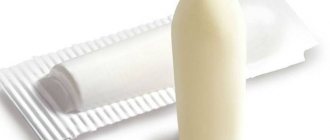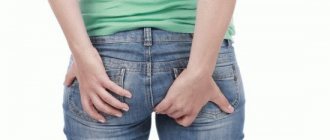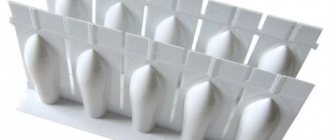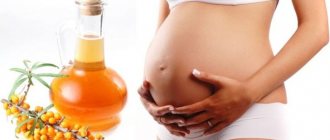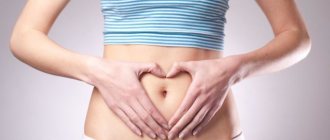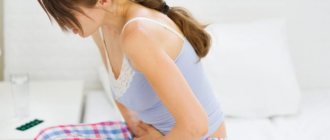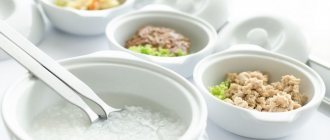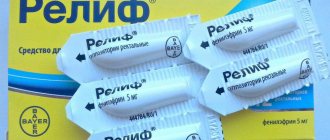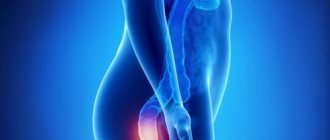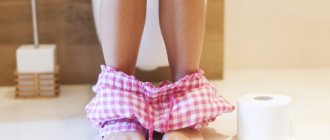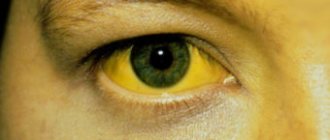Clinical symptoms and manifestations of the disease
Hemorrhoids in a nursing mother occur long before the child is conceived. Predisposing factors are a sedentary lifestyle, unbalanced diet, heavy physical activity and genetic nuances. The disease manifests itself with external and internal signs. Manifestations of external hemorrhoids:
- enlarged, swollen nodes of a bluish-purple color at the entrance to the anus;
- pain and blood during defecation;
- pain when straining, coughing or sneezing;
- burning and discomfort in the anal area.
This type of disease is easier to identify and take certain measures to treat. Internal hemorrhoids develop more slowly: hemorrhoids expand inside the rectum, so it is more difficult to determine this type of disease on your own. Symptoms of the disease are:
- pain and blood during and after defecation;
- feeling of incomplete emptying;
- pain and burning in the anal area.
In addition to the form, experts distinguish 4 stages of hemorrhoids. At the first stage, patients note pain during bowel movements and bloody discharge from the anus. In the last stage of hemorrhoids, fecal incontinence, prolapse of hemorrhoids and severe continuous bleeding are observed.
Reasons for the development of the disease
There are several factors that contribute to the development of postpartum hemorrhoids. A combination of 2-3 of them almost always leads to the development of a disease in the future:
- Genetics. A person inherits the structure and type of the vascular system from his parents.
- Lifestyle. Office work and a sedentary life lead to stagnation in the blood vessels of the pelvis. The tortuous veins begin to expand pathologically under the pressure of the blood overflowing them.
- Physical exercise. Heavy physical labor leads to overstrain of blood vessels, their microtraumas and ruptures.
- Constipation. Long-term stretching of the rectum by feces leads to changes in the hemorrhoidal plexuses.
- Stress, infection, anal sex, inflammatory diseases and other factors.
Any of these reasons is a predisposing factor for the development of hemorrhoids, and their combination causes the development of the disease in most patients. During pregnancy and after childbirth, hemorrhoids develop under the influence of several reasons: increased pressure and stress on the rectum, digestive problems, changes in hormonal levels - all this provokes the development of the disease in most women while carrying a child.
Principles of disease therapy
Treatment of hemorrhoids with hepatitis B depends on its form and stage. At the initial stages use:
- Laxatives to relieve constipation and soften stool.
- Normalization of the daily routine and limitation of physical activity.
- Physiotherapeutic methods.
- Local remedies: creams, ointments, suppositories.
- Phytotherapy.
In more advanced stages of hemorrhoids, conservative and surgical methods are used:
- Minimally invasive techniques: sclerotherapy, coagulation and other methods of alloying hemorrhoids.
- Surgical interventions include surgical removal of these nodes.
Experts recommend treating hemorrhoids during lactation with surgical methods only in severe advanced cases, when conservative treatment does not produce results and the woman suffers from bleeding.
Suppositories are effective for treating internal hemorrhoids, ointments are effective for treating external hemorrhoids.
Rectal suppositories (suppositories) for hemorrhoids during hepatitis B
Treatment of hemorrhoids during lactation includes the use of various local remedies. This method has a minimal systemic effect on the body and helps the woman continue feeding. A number of drugs can have a negative effect on the baby, so before using them you need to study the instructions and consult a doctor.
Candles prohibited for hepatitis B
These medications work well, but contain substances that are contraindicated during breastfeeding:
- Anuzol. Contains belladonna extract, xeroform, glycerin and zinc sulfate.
- Anestezol. Contains anesthetic - benzocaine, zinc oxide, bismuth and menthol. When used during breastfeeding, lactation should be stopped for a while.
- Proctosedyl M. A combined product with many active ingredients: benzocaine, hydrocortisone, framycetin, butamben and others. Prohibited for use during pregnancy and breastfeeding.
- Ultraproct. It contains fluocortolone in several forms, which provides a long-lasting anti-inflammatory effect. There is no data on the use of this remedy for breastfeeding, so before use you should visit a specialist and not use it yourself.
- Betiol. It contains belladonna extract, which can have a negative effect on the baby’s nervous system during lactation.
- Nigepan. Contains benzocaine and heparin. Safety during hepatitis B has not been established.
- Hepatrombin G. The composition includes heparin, polidocanol and prednisolone. Heparin is an anticoagulant that prevents the formation of blood clots in the nodes, prednisolone relieves swelling and inflammation, and polidocanol has a local anesthetic effect. Studies on penetration into breast milk and effects on children have not been conducted.
Suppositories allowed during lactation
In the absence of allergies and individual intolerance, these drugs are allowed to treat postpartum hemorrhoids in breastfed women.
Relief
Prescription drug. Active ingredients: shark liver oil and phenylephrine hydrochloride. Among the auxiliary components: vitamin E, lanolin, glycerin, thyme oil, etc. Use of the drug during breastfeeding should be short-term and in any case not exceed 14 days.
Dosage: used after bowel movements, 2 suppositories per day (morning and evening).
Procto-glivenol
They contain tribenoside (improves vascular tone) and lidocaine, which has an analgesic effect.
Dosage for a nursing mother: apply in the morning and evening, 2 suppositories per day.
Natalsid
Natalsid is allowed during lactation. It contains a natural polysaccharide from brown algae - sodium alginate, as well as brown fat. It has an anti-inflammatory, restorative and analgesic effect.
Dosage: 1 suppository 2 times a day, treatment period - up to 14 days.
Posterisan
The active effect is exerted by microbial cells of E. coli killed by phenol; it also contains fats. This remedy increases local immunity and is approved for use after childbirth by a nursing mother and during pregnancy.
Dosage: 1 suppository 2 times a day, morning and evening, treatment period - 14-21 days.
Olestesin
Prescription combination drug. Active ingredients: sea buckthorn oil, benzocaine, sulphaethidol. Sea buckthorn oil has an anti-inflammatory and wound-healing effect. Benzocaine is a local anesthetic. Sulfaethidol has an antimicrobial effect.
Dosage: 1 suppository 2 times a day: morning and evening, treatment period - 5-7 days.
Sea buckthorn suppositories
They contain a concentrate of sea buckthorn oil, which contains vitamin K. The oil has a stimulating and healing effect.
Suppositories with propolis
Propolis has anti-constipation and antimicrobial effects. Suppositories with propolis are natural and approved for use in hepatitis B, if the child and mother do not have an allergic reaction to bee products. All of these drugs are used according to strict indications, when the expected benefit to the mother outweighs the potential harm to the breastfeeding baby.
Safer are candles with natural ingredients (oils, fats, algae alginate). With severe hemorrhoids, pain and inflammation, natural remedies may not be enough and medications will be required.
If symptoms of the disease occur, you should visit a doctor. After the examination, the specialist will explain in detail how to treat hemorrhoids when feeding a child.
Reviews
Polina, 27 years old: Gepatrombin G ointment helped me well. The contraindications indicate that it is not for the first trimester of pregnancy, and there are no restrictions when breastfeeding. It can be effective when the node is large and very painful. I applied it for three days in a row, the formation decreased, I was even able to sit without pain. I hope the hemorrhoids will go away completely.
Maria, 31 years old: I felt pain during pregnancy. Since not everything is suitable for treatment for expectant mothers, I used Heparin ointment. When I gave birth, the pain intensified and itching appeared, so I was prescribed Proctoglivenol. I tried to smear the inflamed area twice a day, but the ointment has a specific smell, although the result is felt quickly.
Anna, 37 years old: Postpartum hemorrhoids got so bad that even walking was painful. Minor bleeding began to bother me more and more often, but while I was breastfeeding my son, I did not want to use any strong medications. I had to put up with the unpleasant smell of Vishnevsky’s ointment, the compresses helped well, and when the milk ran out, I was already treated with Relief.
Found an error in the text? Select it, press Ctrl + Enter and we will fix everything!
https://youtu.be/Tnrmq0ESkng
Ointments for hemorrhoids during breastfeeding
Internal hemorrhoids are easier to treat with suppositories, but external manifestations are preferably treated with ointments and creams.
What can be treated
- Bezornil. A complex product with astringent, anti-edematous and anti-inflammatory effects. Contains artificial musk, bezoar, amber, zinc.
- Levomekol. It combines methyluracil and chloramphenicol. Has an antiseptic and healing effect. Low toxic.
- Troxevasin. Available in gel form, the active component is a venotonic, which strengthens the vascular wall.
- Relief. The composition is the same as suppositories, so it can be used during lactation.
Treatment is not recommended
- Vishnevsky ointment. For external use only, may cause an allergic reaction.
- Heparin ointment. Heparin contains benzocaine (anesthetic). There are no data on use during breastfeeding.
- Aurobin. It includes prednisolone, lidocaine and dexpanthenol. It cannot be used in the 1st trimester of pregnancy, and in the future - only if there is no effect from other means and for strict medical reasons.
- Proctosan. It includes bismuth, lidocaine, bufexamak and others. Do not use in pregnant and nursing mothers.
- Proctosedyl. The combined ointment is similar in composition to the same suppositories. It has a complex effect, but may be unsafe for breastfeeding women.
An ointment for hemorrhoids during lactation is selected by the attending physician: it must be effective and not contain prohibited components. Ointments have virtually no systemic effects and poorly penetrate into breast milk, but in the presence of allergic sensitivity, even a small amount of the allergen can trigger an adverse reaction.
During the entire treatment period, you need to carefully monitor the child and if negative effects appear, stop breastfeeding for the duration of therapy.
Eliminating constipation: safe methods
One of the risk factors for hemorrhoids is problems with bowel movements. The following remedies can help safely relieve constipation in a nursing mother:
- Duphalac is a lactulose-based laxative. Safely promotes bowel movements and softens stool.
- Glycerin suppositories. Glycerin suppositories gently promote bowel movements.
- Microlax - microenemas that have a laxative effect. Suitable for newborns, pregnant women and nursing mothers.
Another safe way to relieve constipation is a diet that includes foods with a laxative effect, such as kefir, prunes and others.
Traditional medicine and diet
Treatment of hemorrhoids during breastfeeding, in addition to medications, includes a certain diet. The menu should include foods rich in fiber (fruits, vegetables, grains), maintaining water balance, as well as eating foods that help soften and expel feces (prunes, dried apricots, blueberries). Sweets, smoked foods, pickles, as well as alcoholic drinks and soda are excluded from the diet. This menu helps eliminate constipation and helps cure hemorrhoids.
Alternative medicine offers many methods that help treat postpartum hemorrhoids during breastfeeding. Most popular recipes:
- Baths with decoctions of medicinal herbs (oak bark, chamomile, sage). Such baths should be cool to tone the venous walls.
- Homemade ointments and suppositories are used for external manifestations of the disease. Ointments and suppositories are prepared on the basis of lanolin, badger fat and add other active ingredients: mumiyo, Kalanchoe, propolis, honey.
- Enemas with decoctions of medicinal herbs.
- Cold compresses with sea buckthorn oil.
Surgical intervention: when is it used?
If conservative methods of treating hemorrhoids are ineffective, minimally invasive surgical techniques are offered:
- Sclerotherapy. Sclerosants are injected into the hemorrhoids. These are substances that cause obliteration (sticking together) of blood vessels.
- Cryotherapy. Destruction of hemorrhoids under the influence of low temperatures.
- Doping of vessels with a latex ring. The vessel is clamped with special rings, and it becomes empty.
- Coagulation. Under the influence of infrared irradiation, the vessels are sealed.
In severe cases, classical operations are used - hemorrhoidectomies.
What to do to get rid of the problem faster
A radical method of treating hemorrhoids is hemorrhoidectomy (surgical excision of nodules), but it is only indicated for:
- internal pathology III degree;
- lack of results from drug treatment and the impossibility of manual reduction of nodes;
- contraindications or obviously clear ineffectiveness of minimally invasive treatment methods.
Minimally invasive methods for removing nodes mean:
- ligation;
- infrared coagulation;
- sclerotherapy.
Ligation of hemorrhoids with latex rings
These techniques are safer and more convenient than surgery, but their use is not always possible. The choice of radical treatment methods is decided in consultation with the attending physician.
The fastest way to get rid of hemorrhoids after childbirth:
- eliminate acute symptoms with the help of locally acting drugs - suppositories, ointments;
- if necessary (if prescribed by a doctor), take a course of phlebotonics to strengthen the walls of the venous vessels;
- exclude factors that can provoke an exacerbation (sedentary lifestyle or excessive physical activity, spicy food, alcohol, constipation).
Special exercises to eliminate blood stagnation in the pelvis, which are useful to perform after eliminating the acute symptoms of the pathology, have a good effect. Fulfillment of these conditions will be the key to a speedy recovery if the woman shows persistence and discipline. How to remove belly fat after childbirth and do you need a bandage?
